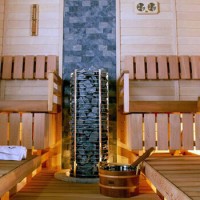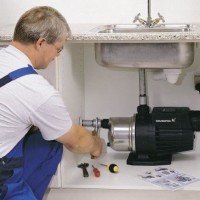Decorating walls with decorative plaster - modern ideas
Decorative plaster for interior wall decoration is a modern, practical material.With its help, a varied texture is created on surfaces. If desired, the top is coated with paints and varnishes.
The content of the article:
Samples of decorative plaster
The popularity of decorative material for finishing interior walls of an apartment is explained by its affordability, as well as the unusualness and variety of textures obtained.
Classic examples show that using plaster you can tidy up an uneven wall. And the examples with examples of decorative finishing attract attention due to the unusualness of the finishing result, which can decorate a room decorated in any style from classic to modern.
Samples can be found in the photo below.
Types of decorative plaster
There are four types of materials for interior wall decoration, differing in composition:
- Mineral. The base is mixed with gypsum, lime or cement.
- Acrylic. The element for connecting all components are acrylic resins.
- Silicate. In such mixtures for interior wall decoration, liquid glass is responsible for combining the components.
- Silicone. Synthetic resin makes the mixture viscous and solid.
Dividing decorative plaster according to the size of the crumbs used in the composition provides another classification.
This moment will affect the thickness of the layer obtained on the wall and the type of texture.
Kinds:
- Large-textured contains crumbs measuring 3-5 mm.
- Medium texture – 1.5-3 mm.
- Fine-textured – 0.5-1.5 mm.
- Fine-textured - the fine crumbs in its composition are called stone flour. Its diameter is up to 0.5 mm.
You can watch a video about the types of decorative plaster.
Composition of decorative plaster
The composition of decorative plaster for interior wall decoration includes:
- filler;
- components for communication, modeling;
- color pigments.
Fillers
As a filler for interior decoration, marble or granite (stone) chips or flour are used, depending on the required size.
The next most popular option are fibers of synthetic or natural origin and the same granules. They create a unique pattern on interior walls.
Colors
Pigments are used in the production of colored decorative plaster. These can be both natural and artificial dyes. The intensity of the color depends on the pigment and its amount mixed into the solution.
The coloring for interior decoration can be any, the palette is rich, so there are no problems with choosing a color.
Modeling and bonding components
Various resins can be selected as modeling and binding components:
- mineral;
- acrylic;
- silicate;
- silicone.
Test application of decorative plaster
This is a relatively new type of coating. Not everyone likes decorative plaster. Therefore, it is worth trying the mixture on a small area of the wall.
First, prepare the surface. A deep penetration primer is used. After complete drying, the plaster is applied evenly.
The first layer is made thin. It will smooth out uneven surfaces and prepare the base for further finishing.The second layer allows you to give the surface texture.
Glazing
This involves applying a glazing composition to the treated wall. It allows you to create a deep color transition on the surface.
The strength of the effect will depend on the number of layers applied to the plastered surface. For work it is best to use a sponge. It will add a special shine and repeat the intended texture of the wall.
Application Tools
The effect of the finished finishing depends not only on the quality of the plaster mixture used and the skill of the worker, but also on the tools chosen.
To work you need to prepare:
- Drill with mixing attachments or mixer for plaster and cement.
- Spatulas of different sizes and shapes for smoothing the first layer and applying the second.
- Rollers, brushes, graters are tools for creating the texture of a decorative layer.
The uniqueness of the decor will depend on the needs and skills of the person doing the finishing. If you do everything yourself, then no one else will have such a wall.
Preparing walls for plastering
Any surface of internal walls is suitable for applying the composition, from classic concrete to unique metal.
Experts warn that the result will depend on the quality of the wall preparation. First of all, it is recommended:
- level the surface;
- clean it;
- dry.
It is recommended to start with priming. Before applying the decorative composition, the soil must dry completely.
Making a lining for Venetian plaster
Venetian plaster for interior wall decoration is a capricious, demanding material. For finishing you need a perfectly flat wall, otherwise the work will be ruined beyond the possibility of correction.
Step by step procedure:
- Stripping wallpaper, paint, whitewash and other old covering of the interior walls of the room.
- Leveling the surface using beacons.
- Plastering. It will allow you to level out the remaining potholes and strengthen the surface.
- Leveling using putty.
- Grinding. The work is carried out only manually, which allows you to control the pressing force, speed and uniformity of movements.
- Applying primer.
Failure to carry out any of the preparation stages correctly will affect the subsequent application of Venetian plaster.
Techniques for applying to the wall
Mineral decorative plaster can be applied in several ways, which are combined into two large groups:
- Hand finishing. It is distinguished by the use of different tools (brushes, spatulas, graters and graters). The solution is applied to the prepared surface, then distributed over the wall and leveled. One person can do this kind of work.
- Technological mechanical application. You will need at least two people to do the job. The most commonly used method is spraying the solution onto the wall from a special device. In this case, the first person applies the solution, the second immediately begins to distribute it over the surface.
When comparing, we can say that mechanical application is more profitable in terms of saving effort. But at the same time, it will not provide the same degree of painstakingness as manual finishing. Working with a spatula and grater allows a person to “feel” the thickness of the layer with his fingers.
Drying treated walls
When drying the wall, it is worth considering what composition was applied to it:
- colored decorative plaster;
- classical.
The simpler the composition, the easier it will be to dry the coating.It is recommended to monitor the process, otherwise cracks will appear on the surface of the internal walls, detachment will occur, and voids will form inside the decorative layer, where mold and fungi can grow.
Ventilation is used to dry the interior walls after coating. The room is provided with a high level of natural air circulation, windows and doors open.
It is worth remembering the need to maintain low air humidity. The finishing material is created on the basis of an aqueous solution, and excess moisture in the air of the room will not only prevent the layers from drying out, but can also significantly deteriorate the quality of the wall finishing.
Another method is called a heat gun. Despite its popularity, it can cause damage to decorative material.
You can also use a special dehumidifier. Its work is not aimed at thermal drying, but at reducing humidity in the circulating air. The drier the air in the room, the easier the undried layer will release water and dry faster.
Use of decorative structural plaster allows you to create an unusual, unique design, the repetition of which is unlikely, especially if the repair was carried out on your own. In this case, attention should be paid to the composition of the solution, the need to make a special lining for it, as when working with Venetian plaster.
What is decorative plaster for concrete - advantages and disadvantages, how to apply it. You can read about this Here.
Preparing the walls and drying them are important stages of repair. Interior decorative finishing can fully reveal its beauty only on well-prepared surfaces.Before finishing begins, specialists’ answers to basic questions are studied.
What kind of interior decoration do you have? Save the article to bookmarks so as not to lose useful information.
Video tutorial on how to apply decorative plaster to a wall.
Sources:
- https://otdelka-expert.ru/shtukaturka/vidy/dekorativnaya-shtukaturka-dlya-sten-1105
- https://www.ivd.ru/stroitelstvo-i-remont/steny/vidy-dekorativnoj-shtukaturki-dlya-vnutrennej-otdelki-sten-sovety-po-vyboru-i-40-foto-primerov-39541
- https://viratools.ru/blog/1481
- https://www.dom.by/gds/dekorativnaya-shtukaturka/dlja-vnutrennih-rabot/minsk





